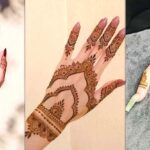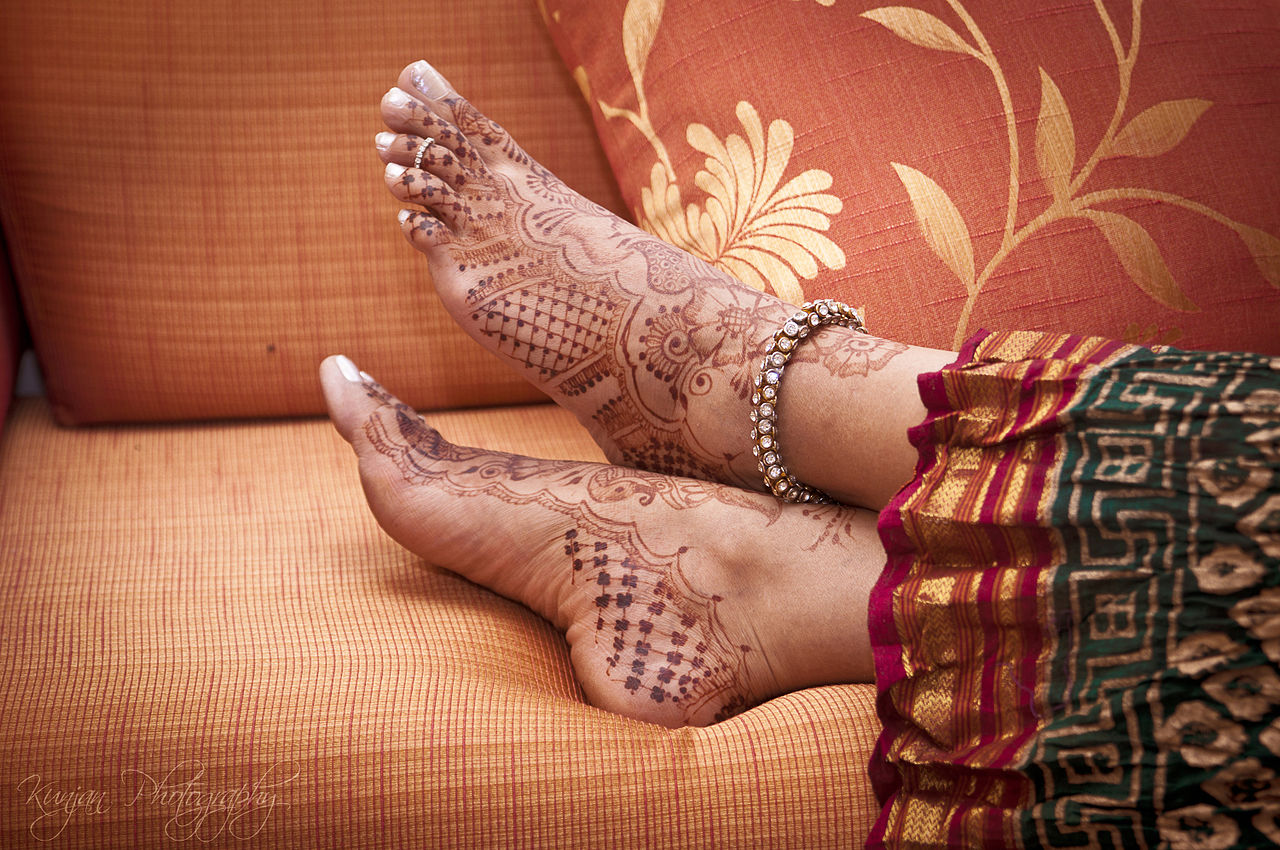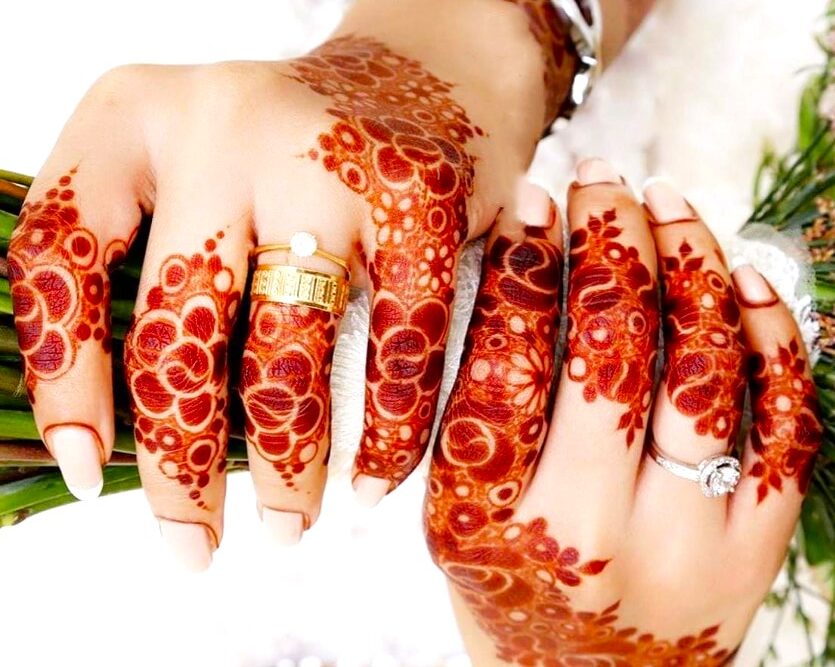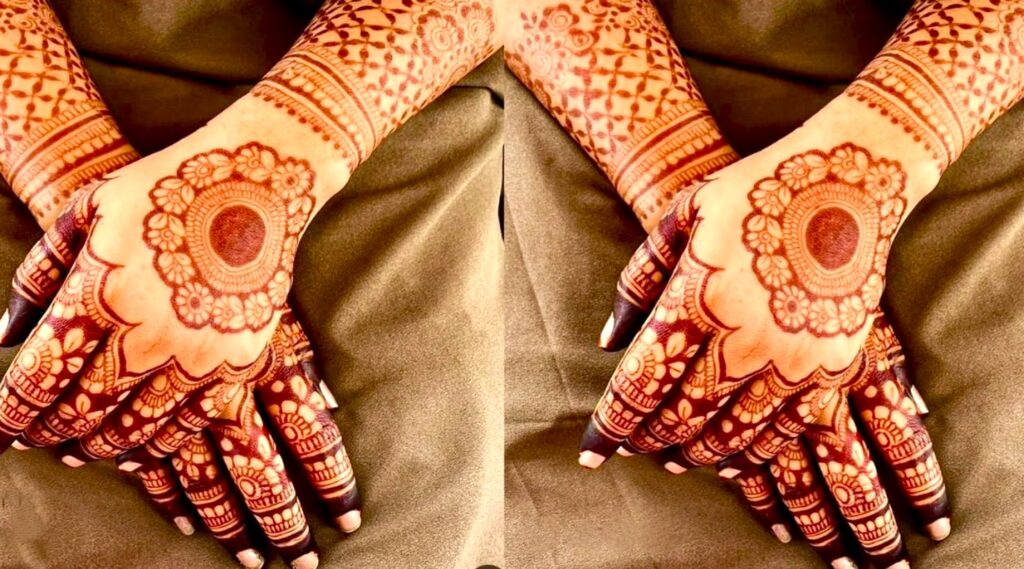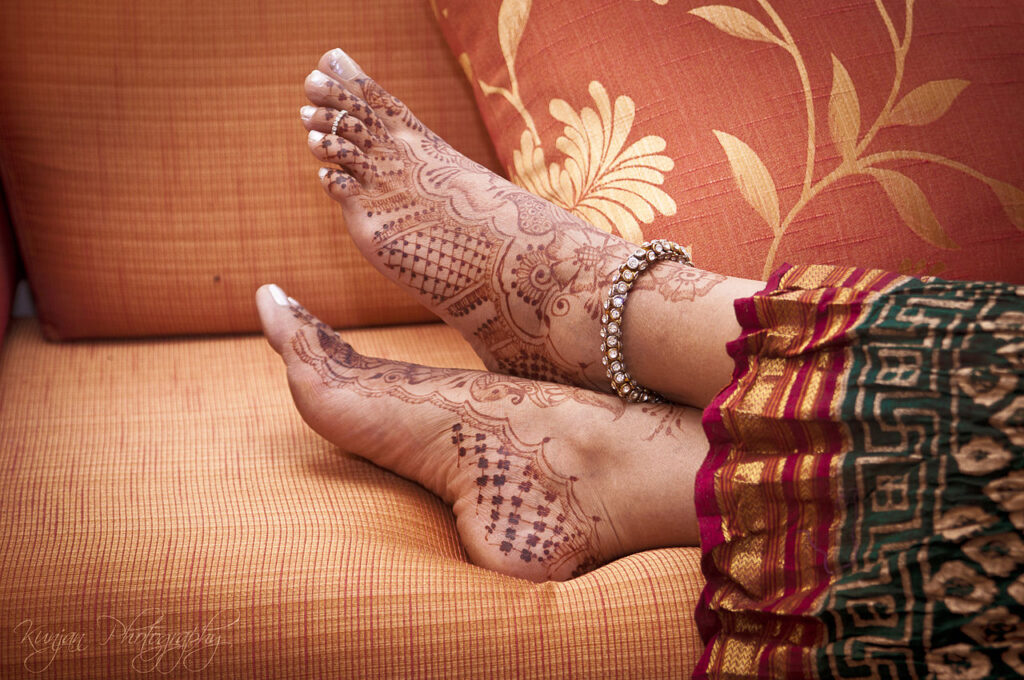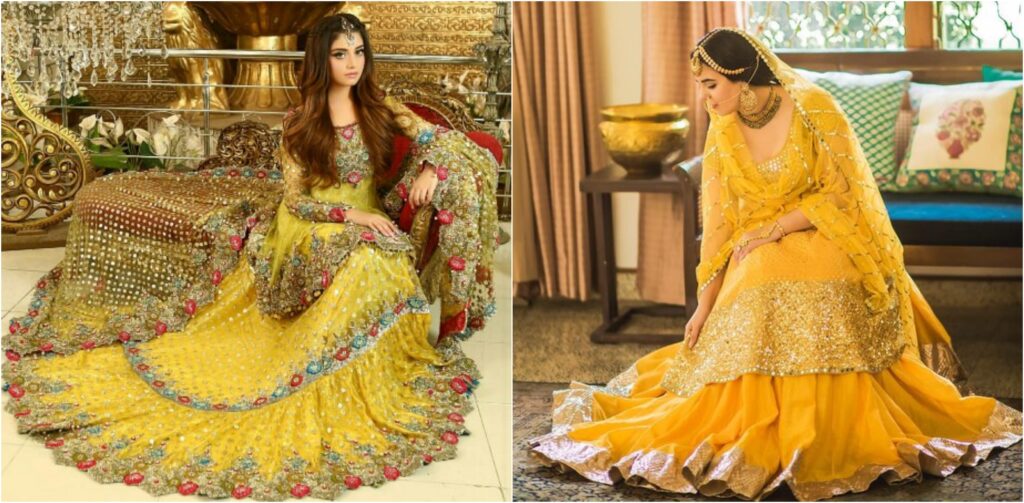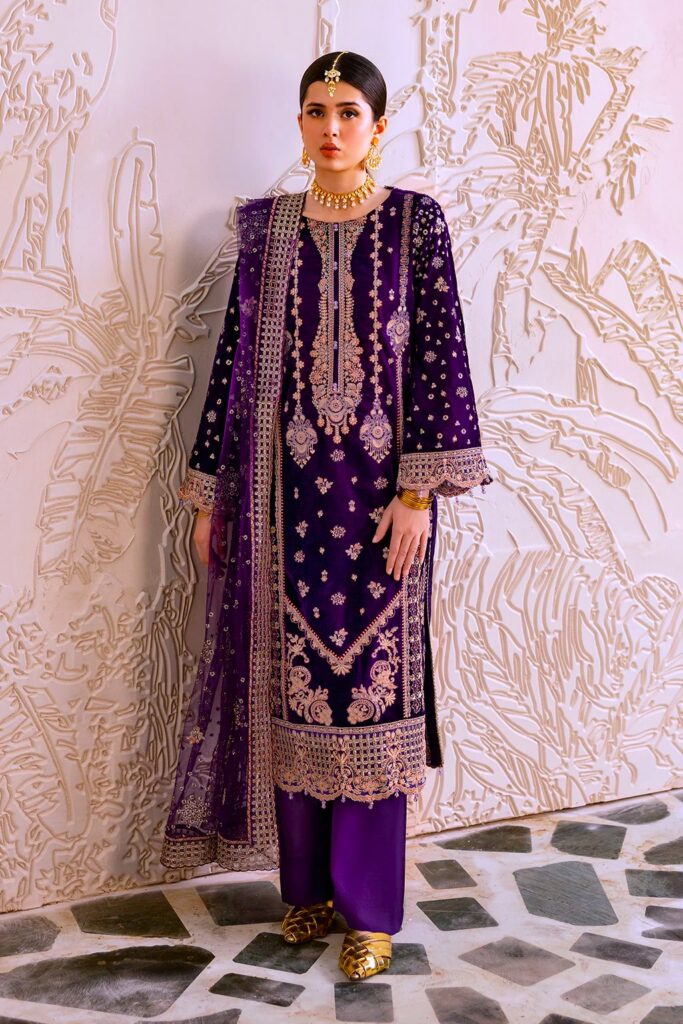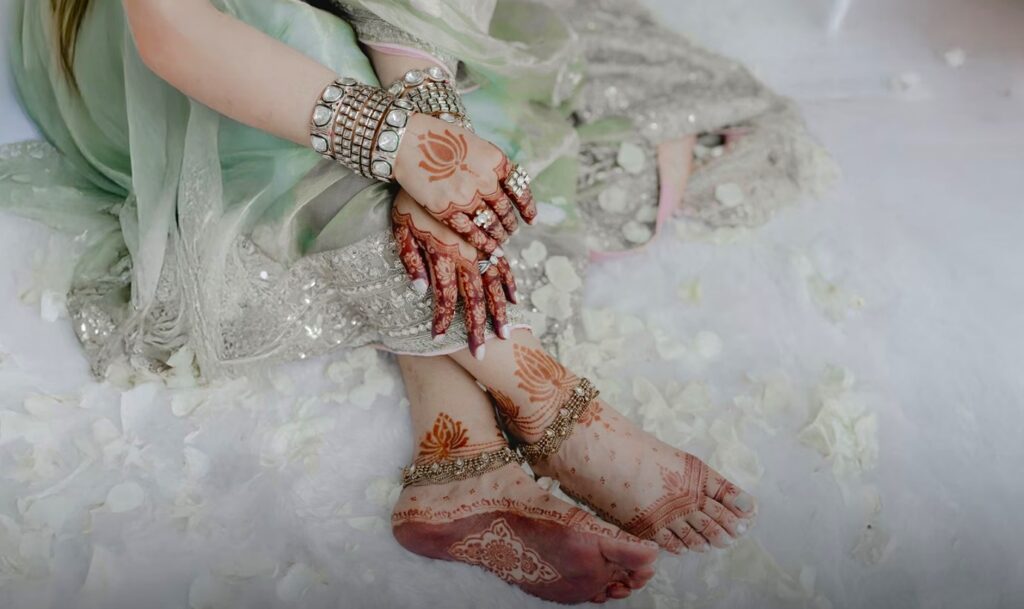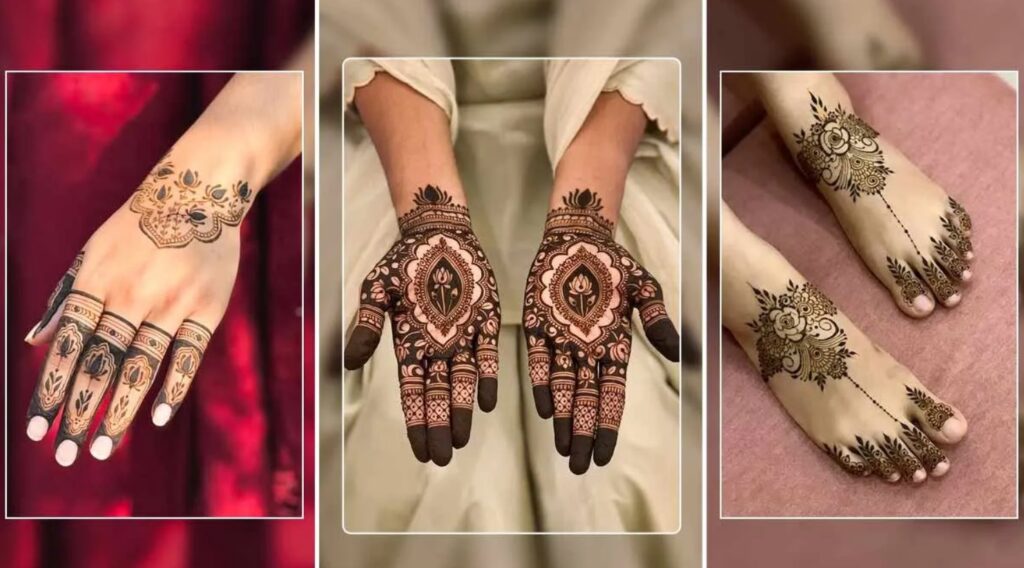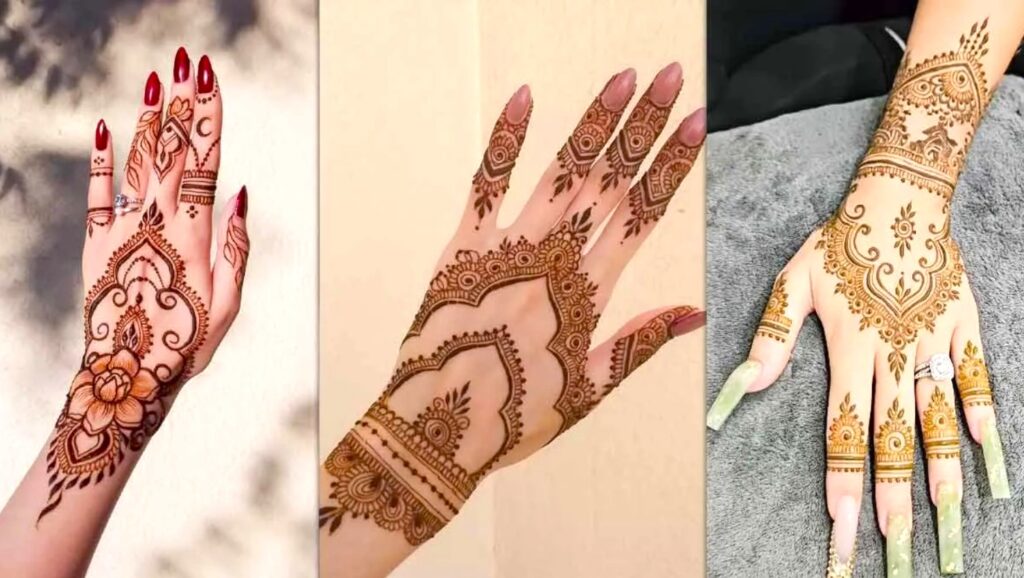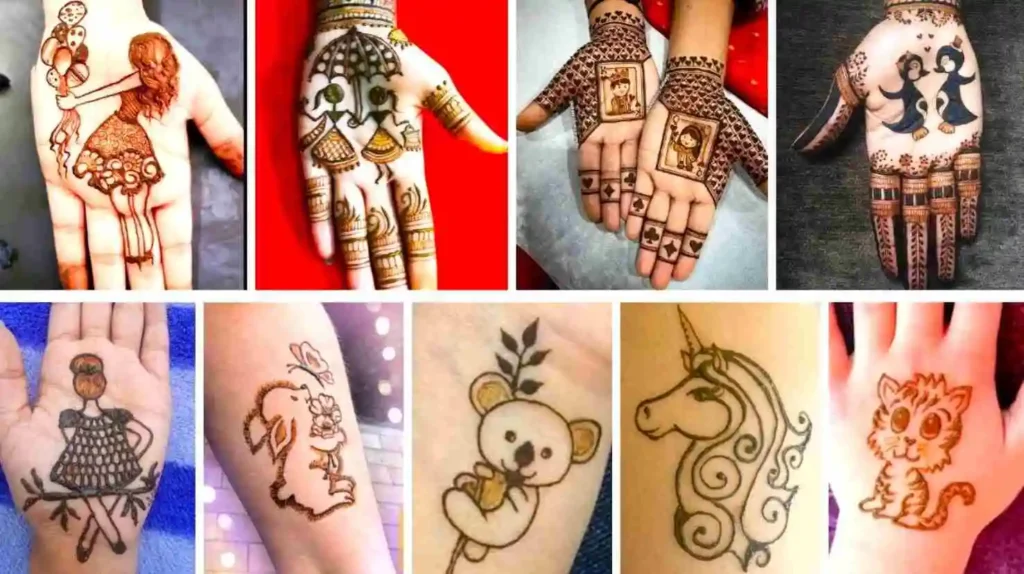Foot Mehndi Designs
The human foot is an often-overlooked canvas, yet it holds a unique potential for breathtaking artistry. A intricate foot mehndi designs is not merely a decoration; it is a silent poem written in henna, a celebration of movement, and a deeply personal statement of style that reveals itself with every step. This ancient art form, rooted in sacred rituals, has exploded into a global phenomenon, blending tradition with avant-garde trends. Whether you are a bride preparing for her wedding, a reveler getting ready for a festival, or someone seeking a beautiful, temporary adornment, mastering the foot mehndi designs is a journey into culture, creativity, and self-expression.
In this definitive guide, we move beyond simple picture galleries to deliver profound value. We will deconstruct the elements of a stunning foot mehndi designs, providing you with the knowledge to appreciate, choose, and apply mehndi like a professional artist. Imagine the perfect synergy: a delicate, lace-like pattern peeking out from elegant sandals, perfectly complementing the rich texture of a royal blue velvet dress design. This is the power of cohesive styling. We will explore how mehndi interacts with modern fashion and how it serves as a non-permanent alternative to a classic tattoo design. This article is crafted to be your ultimate resource—a deep dive that answers every question, addresses every concern, and inspires your next beautiful foot mehndi designs.
Understanding the Canvas: What is a Foot Mehndi Designs?
A foot mehndi designs is the specialized application of henna paste onto the feet, encompassing everything from the ankles down to the tips of the toes. This form of body art is distinct from hand mehndi due to the unique topography of the feet. The arch, the heel, the bony top of the foot, and the toes each present different challenges and opportunities for the artist.
The true artistry lies in creating a flow that complements the foot’s natural lines. A masterful foot mehndi designs will often use the arch as a central axis, with patterns radiating outwards or flowing from the ankle down to the toes like a delicate piece of jewelry. These designs can range from minimalist, single-motif statements to full-foot “stockings” of henna that showcase incredible density and detail. While its origins are steeped in the cultural traditions of South Asia, the Middle East, and North Africa, the appeal of a beautiful foot mehndi designs is now universal, embraced worldwide as a form of elegant, temporary body art.
- Example in Practice: A popular structural technique is to place a large, intricate motif, like a peacock or a detailed mandala, on the main dome of the foot. From this central element, tendrils and vines then extend, wrapping around the arch and snaking towards the ankle and toes, creating a cohesive and balanced look.
A Journey Through Time: The Rich History and Cultural Soul of Mehndi
To truly appreciate a foot mehndi designs, one must understand its profound historical and cultural roots. The story of mehndi begins over 5,000 years ago. Archaeological evidence suggests it was used in ancient Egypt, where Cleopatra herself is said to have used henna to adorn her body, and the Pharaohs had their fingertips stained before mummification.
However, it was on the Indian subcontinent that mehndi evolved into the elaborate art form we recognize today. It became an indispensable part of Hindu, Sikh, and Muslim wedding traditions. The “Mehndi Ki Raat” (Night of Mehndi) is a pre-wedding ceremony filled with music, dance, and celebration, where the bride is adorned with intricate patterns that symbolize love, prosperity, and the sacred bond of marriage. A dark stain is traditionally seen as an omen of a strong, loving relationship. Beyond weddings, mehndi is applied during festivals like Karva Chauth, Eid, and Diwali, marking it as a symbol of joy and blessing.
- Key Cultural Significance Points:
- Fertility and Luck: Mehendi is believed to invoke the blessings of the gods for a fruitful marriage.
- Bridal Seclusion: The application process allows the bride to rest and be pampered before her new life begins.
- Spiritual Connection: The cooling properties of henna are said to soothe the nerves and promote spiritual awareness.
- Protection: In many cultures, it is thought to ward off the evil eye and negative energy.
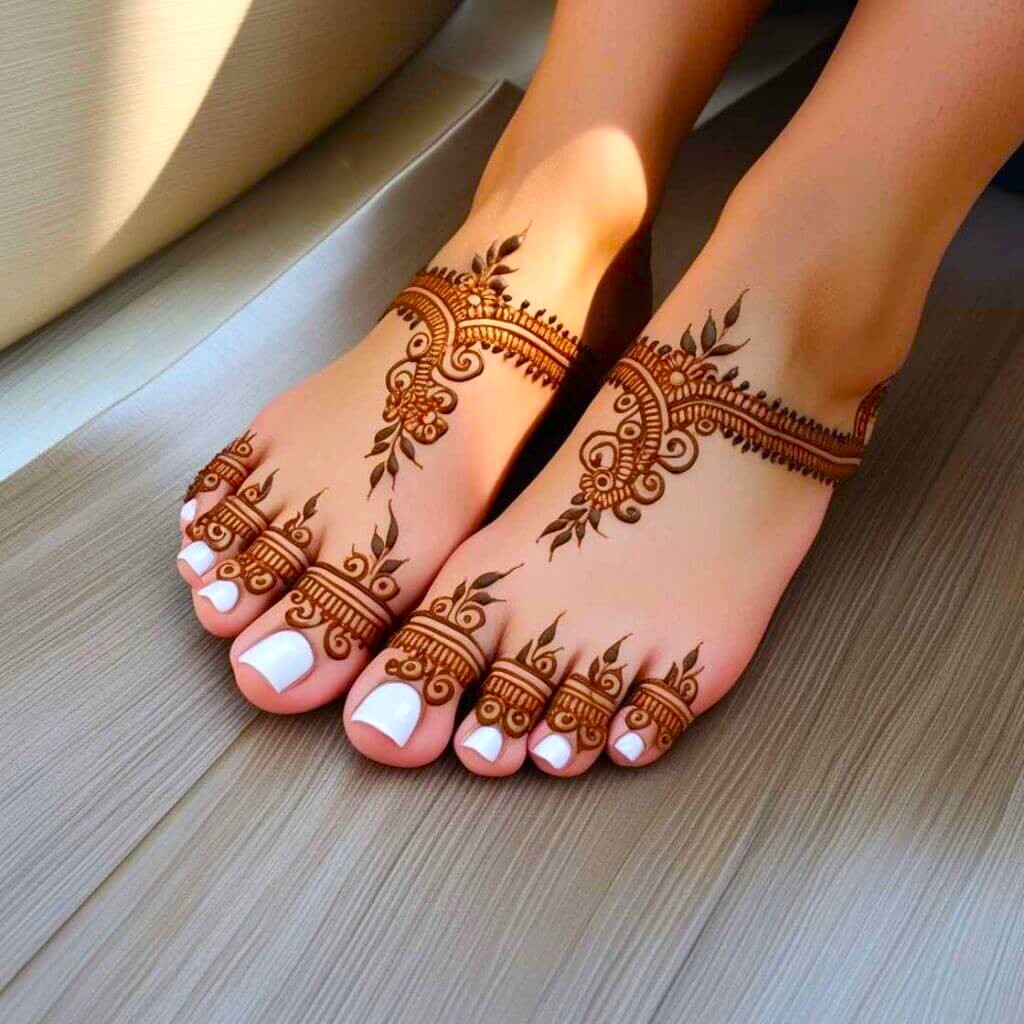
Why It Matters: The Modern Significance of Foot Mehndi
In today’s globalized world, the significance of a foot mehndi designs has beautifully expanded. While it retains its deep cultural importance for millions, it has also been embraced as a pure fashion statement.
- A Symbol of Cultural Pride: For diaspora communities, applying mehndi is a powerful way to connect with their heritage and celebrate their identity during important occasions.
- The Ultimate Fashion Accessory: A foot mehndi designs is the perfect bohemian-chic accessory for a summer music festival, a beach wedding, or a vacation. It adds an element of intricate detail that complements everything from a flowy maxi dress to a sophisticated velvet dress design for an evening event.
- The Temporary Tattoo Alternative: For those who love the look of body art but are hesitant about the permanence of a tattoo design, mehndi offers a perfect solution. It allows for experimentation with different styles and placements without long-term commitment.
- A Form of Mindful Self-Care: The process of sitting still, receiving or applying mehndi, can be a meditative and therapeutic act, a dedicated time for relaxation and beautification.
The 2025 Trend Forecast: What’s Hot in Foot Mehndi Designs
The world of mehndi is dynamic and creative. The trends for 2025 reflect a blend of minimalist elegance, bold fusion, and a return to organic forms. Here’s your exclusive look at what’s trending.
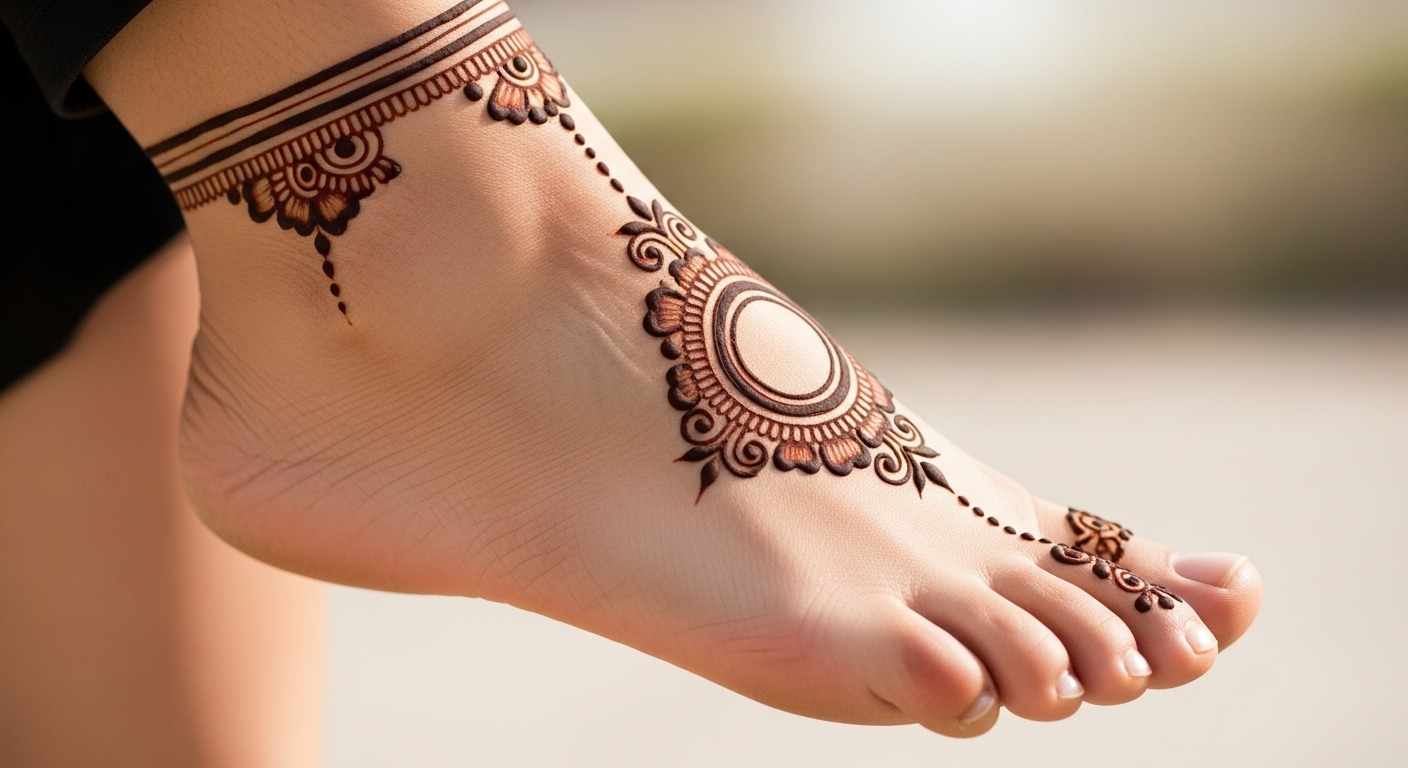
Micro-Mehendi & Delicate Negative Space
The “less is more” philosophy reigns supreme. Instead of full coverage, 2025 is about strategically placed, tiny designs that use the skin as a crucial part of the art. Think of a single, finely detailed flower on the ankle bone, a whisper-thin line tracing the tendon along the foot, or a small geometric pattern on the side of the heel. This style is incredibly versatile and pairs exquisitely with modern, open-toed footwear.
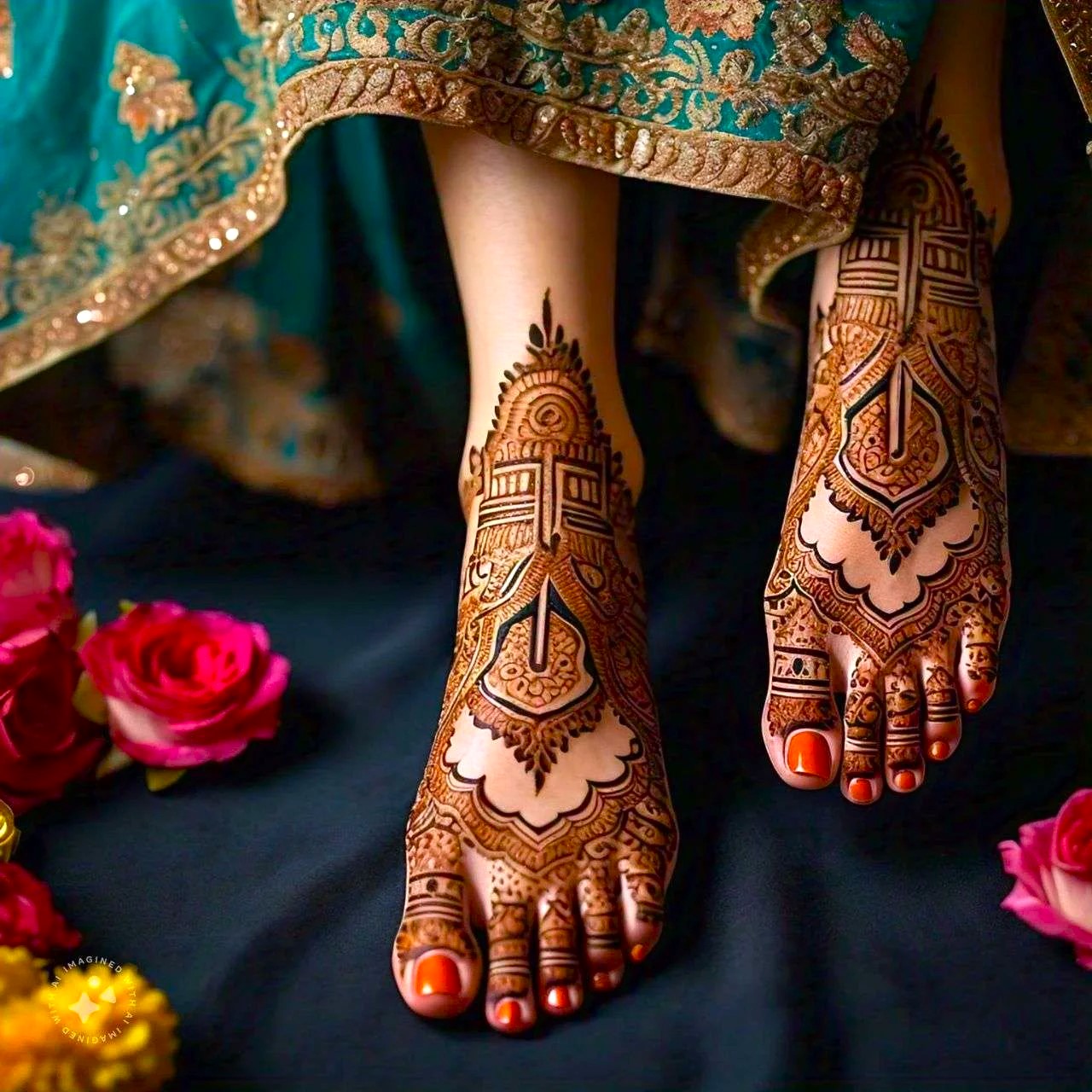
The Structured Fusion: Geometric Paisleys & Architectural Lines
This trend is for the modern traditionalist. Artists are brilliantly fusing classic Indian motifs like paisleys (mangoes) and florals with sharp, clean geometric patterns—think chevrons, triangles, and intricate line work. This creates a visually stunning, contemporary foot mehndi designs that honors its roots while firmly looking toward the future. It’s the aesthetic equivalent of pairing a traditional velvet dress design with minimalist, modern jewelry.
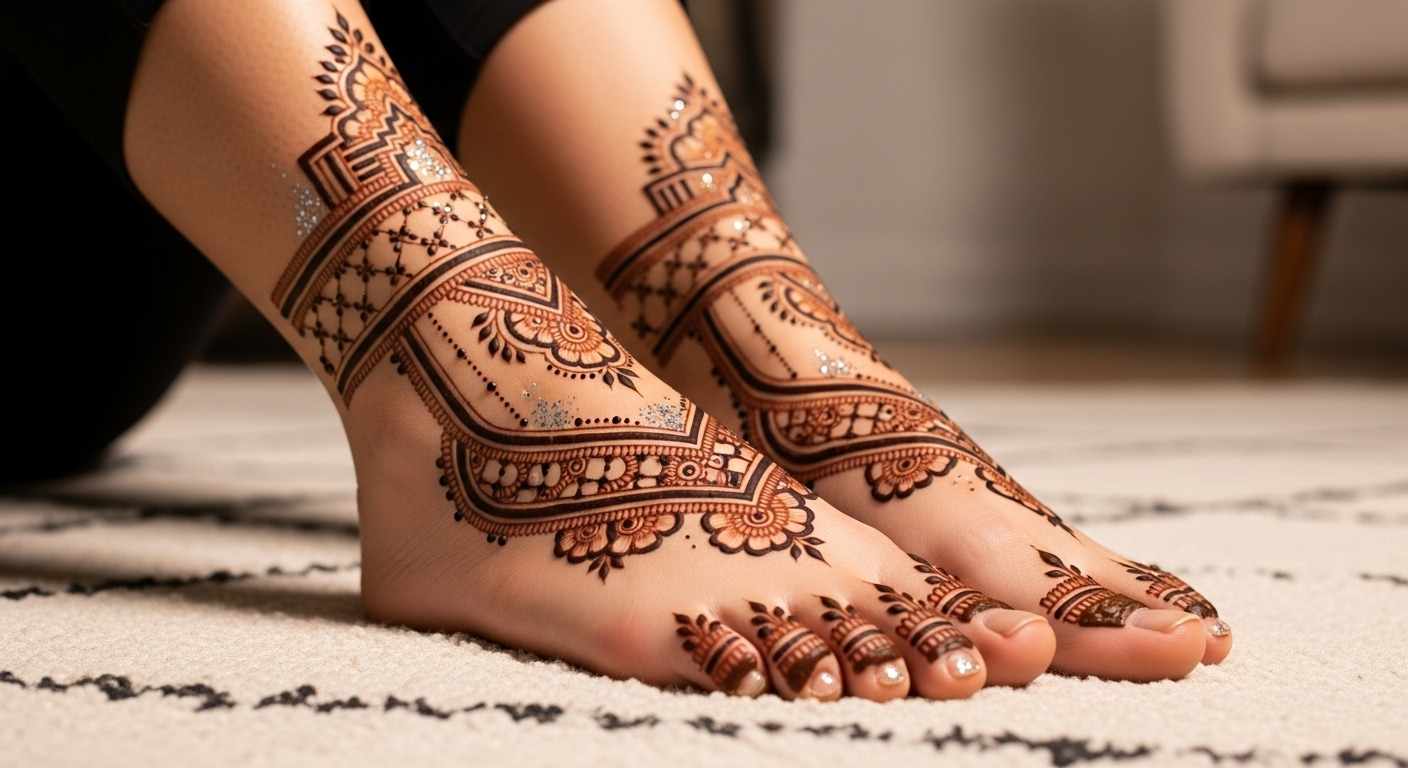
Jewelry-Inspired Illusions: Henna as Adornment
Why wear metal when you can wear art? This trend involves creating mehndi that mimics fine jewelry. Expect to see:
- Intricate Anklets: Patterns that wrap around the ankle, featuring detailed chains, pendant drops, and pearl-like dots.
- Toe Rings & Toe Caps: Delicate designs that look like rings on individual toes, or “caps” that cover the top of the toe with a delicate pattern.
- Strap Designs: Patterns that create the illusion of elegant sandal straps weaving across the foot.
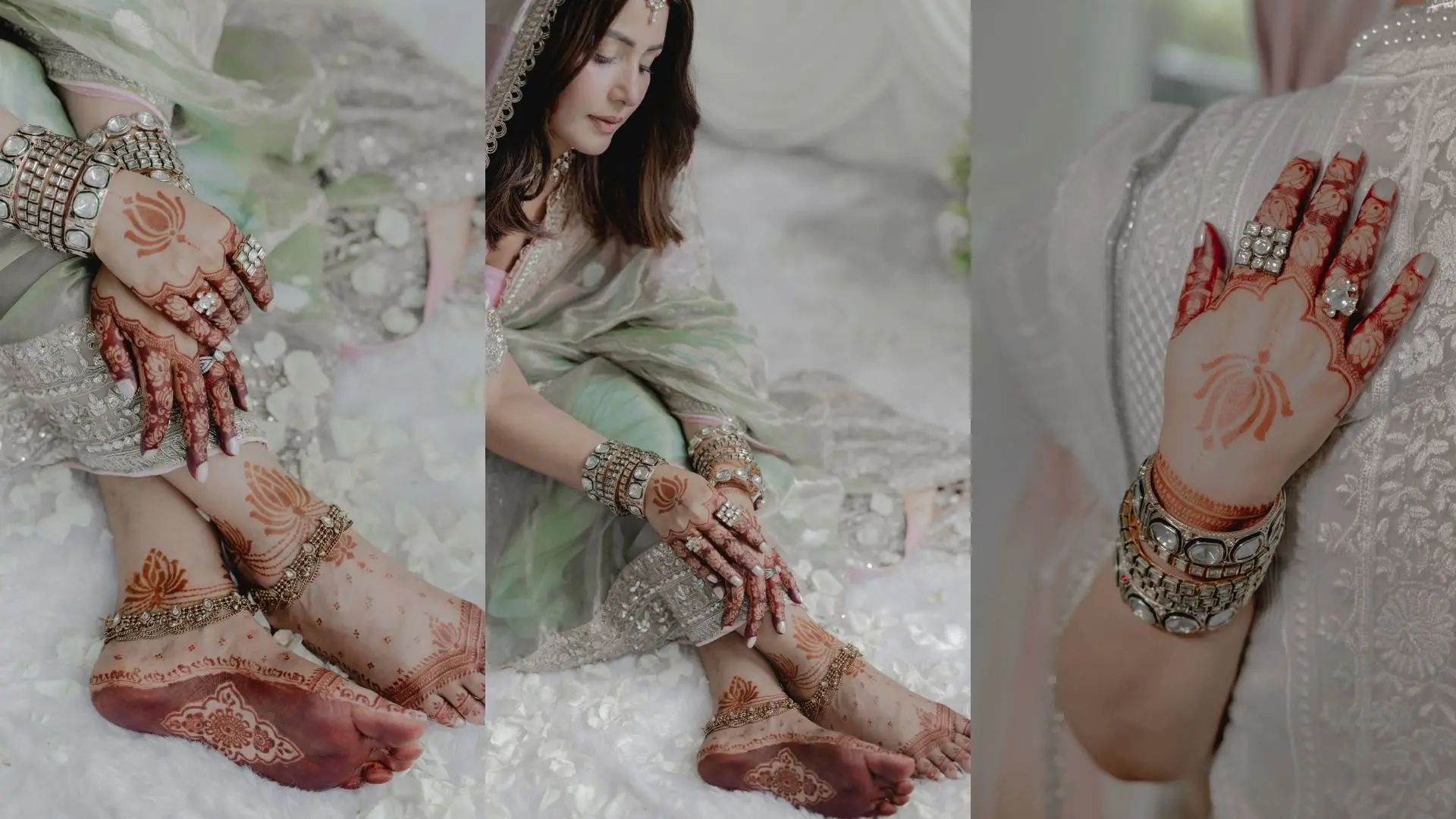
Hyper-Realistic Botanicals & Nature Scenes
Forget stylized flowers. 2025 is about realism. Artists are using finer cones and advanced techniques to draw lifelike botanicals—orchids, ferns, lilies, and even entire scenes of cascading leaves and vines that look like they are naturally growing on the skin. This style is organic, dynamic, and exceptionally elegant, offering a fresh take on the perennial favorite of floral mehndi.
The Ultimate Step-by-Step Guide to Flawless Application
Achieving a professional-looking foot mehndi designs at home is entirely possible with patience and the right technique.
Step 1: Impeccable Preparation
The foundation of a dark stain is clean, prepped skin.
- Exfoliate: Gently use a scrub to remove dead skin cells, creating a smooth canvas.
- Wash and Dry Thoroughly: Use soap and water to remove any oils or lotion, then pat completely dry.
- Apply Essential Oils (Optional): Dab a tiny amount of eucalyptus or tea tree oil on the skin. This can help darken the stain but is not mandatory.
Step 2: Design Selection and Cone Handling
- Choose Wisely: Beginners should start with a simple foot mehndi designs from Pinterest or a stencil. Avoid overly complex patterns initially.
- Test Your Cone: Practice the flow and pressure on a paper towel or your palm. The line should be smooth and consistent.
- Outline Lightly (Pro Tip): For complex designs, use a skin-safe cosmetic pencil or a toothpick dipped in a mix of lemon juice and sugar to lightly sketch the outline. This acts as your guide.
Step 3: The Art of Application
- Start from the Top: Begin your application on the highest point of the foot (the central dome) and work your way down and outwards. This prevents you from smudging completed sections.
- Maintain Steady Pressure: Hold the cone like a pen and apply steady, even pressure. The paste should lay on the skin like a tiny rope, about 1-2 mm thick.
- Anchor Your Hand: Rest the side of your drawing hand on your foot or a stable surface to prevent shaking.
Step 4: The Crucial Drying & Sealing Process
- Let it Dry Naturally: Allow the paste to dry completely on its own. This can take 1-2 hours. Avoid fanning or blowing on it.
- Create a Sugar-Lemon Sealant: Mix one tablespoon of lemon juice with two tablespoons of white sugar. Once the paste is dry to the touch, gently dab this mixture over the design with a cotton ball. This seals the design, keeps it flexible, and prevents premature cracking.
- The Long Wait: For the darkest stain, you must let the paste sit for 6-8 hours, or ideally overnight.
The Honest Breakdown: Benefits and Drawbacks
Being informed helps set realistic expectations.
The Compelling Benefits
- Natural and Safe: Pure, natural henna is a plant-based product, free from the harsh chemicals found in some cosmetics and hair dyes.
- Therapeutic Process: The act of applying or receiving mehndi is often a calming, social, and meditative experience.
- Total Customization: Your foot mehndi designscan be as unique as you are, tailored to your personal style, unlike mass-produced accessories.
- Non-Permanent: It allows you to change your body art as often as you change your outfit, without the commitment of a permanent tattoo design.
The Realistic Drawbacks
- It’s Temporary: The stain will fade naturally within 1-3 weeks, requiring reapplication.
- Time-Intensive: A good application and drying process requires a significant time investment.
- Risk of Allergies (with Black Henna): This is critical. So-called “black henna” often contains PPD (para-phenylenediamine), a chemical that can cause severe allergic reactions, blistering, and permanent scarring. Always insist on natural, brown henna.
- Variable Results: The final stain color can vary based on your body chemistry, the quality of the henna, and your aftercare diligence.
Expert Secrets for a Dark, Long-Lasting Stain
Go from amateur to pro with these insider tips.
- Embrace Body Heat: The dye in henna releases best in warmth. Before application, soak your feet in warm water or use a warm towel. After application, wear socks to generate gentle, consistent heat.
- The Overnight Rule: This is the single most important factor. Leaving the paste on for 8+ hours allows the dye to fully penetrate the skin cells. Wrap your feet loosely in tissue and wear socks to bed to protect the design and your sheets.
- The 24-Hour Water Ban: After the paste falls off, the stain is still setting. Avoid washing your feet with soap and water for at least 12-24 hours. When you must wash, use only cool water and pat dry.
- Oil, Don’t Moisturize: For the first few days, seal in the stain with natural oils (coconut, olive, or mustard oil). Avoid water-based lotions, as they can accelerate the fading process.
Finding Your Muse: A World of Inspiration
Your perfect foot mehndi designs is out there. Here’s where to look and how to choose.
- For the Traditional Bride: Seek out Indian Bridal designs. These are characterized by high density, intricate patterns that often cover the entire foot and extend up the calf. They frequently incorporate symbolic elements like peacocks, lotus flowers, and hidden initials of the groom.
- For the Bohemian Spirit: Arabic style mehndi is a great inspiration. It features bold, large floral motifs and sweeping lines with plenty of negative space, creating a less dense, more fluid look. Pair this with a flowing dress and bare feet on the beach.
- For the Modern Minimalist: Look at Contemporary & Geometric styles. These are heavily influenced by modern tattoo design trends, using fine lines, dotwork, and abstract patterns. They are perfect for a professional setting or when you want a subtle accent to a sleek velvet dress design.
- For the Cultural Explorer: Explore African or Moroccan patterns, which often feature distinct geometric shapes, rhombuses, and zig-zag lines, offering a strikingly different aesthetic.
Don’t Make These 5 Common Mistakes
Avoid these pitfalls for a perfect result every time.
- The Hairdryer Blunder: Using direct, hot air to dry mehndi “fries” the paste, causing it to crack and flake off too early, resulting in a very light stain. Always air-dry.
- Applying on Oily or Moisturized Skin: Lotions and natural skin oils create a barrier that blocks the dye. Always wash and dry feet immediately before application.
- Poor Planning Leading to Smudges: Diving into a complex design without a plan often means your hand rests on wet paste. Always have a clear application path from top to bottom.
- Using Old or Low-Quality Henna: Henna paste has a shelf life. If it’s been in your drawer for a year, it’s lost its potency. Invest in fresh, reputable cones or paste.
- Picking at the Dry Paste: As it dries, the paste will crack and feel tight. Resist the urge to pick at it! Let it fall off naturally to avoid pulling out the dye before it has set.
The Future of Foot Mehndi: What’s Next?
The evolution of foot mehndi designs is accelerating. We are on the cusp of seeing:
- Colored Henna and Embellishments: The use of safe, skin-friendly colored henna (blues, golds, whites) and the incorporation of glitter and gems for festive events.
- Digital Meets Traditional: Artists using digital tablets to design patterns and project them onto the skin for perfect outlines.
- The “Tattoo-Realism” Fusion: The line between a temporary foot mehndi designs and a permanent tattoo design will continue to blur, with artists creating hyper-realistic portraits and scenes that were once only possible with ink.
- Personalized & Thematic Designs: Mehendi will become even more personalized, telling specific stories or representing personal milestones, much like a custom-designed piece of jewelry.
Frequently Asked Questions (FAQs)
1. How can I make my foot mehndi designs last longer than 3 weeks?
While 3 weeks is typically the maximum, you can extend it by minimizing friction (wear open-toed shoes), avoiding long soaks in water, and applying a natural oil barrier daily. The stain fades as your skin exfoliates, so gentle care is key.
2. I have sensitive skin. Is a natural foot mehndi designs safe for me?
Pure, natural henna (made from Lawsonia inermis plant) is generally very safe. However, always conduct a patch test 24-48 hours before a full application. Apply a small dot of paste behind your ear or on your inner arm and monitor for any reaction.
3. What’s the real difference between mehndi and a tattoo design?
The core difference is permanence and process. Mehndi stains the epidermis (top layer of skin) and fades away. A tattoo design involves injecting ink into the dermis (second layer), making it permanent. Mehndi is painless and cultural; tattoos are painful and a form of modern body modification.
4. Can I create a foot mehndi designs that looks like lace?
Absolutely! Lace-inspired foot mehndi designs is a major trend. It involves creating fine, interconnected patterns with lots of negative space, mimicking the look of delicate lace stockings. This requires a skilled hand and a very fine-tipped cone.
5. My stain is always orange, not dark brown. What am I doing wrong?
An orange stain typically indicates the dye didn’t penetrate deeply. The most common causes are: 1) Leaving the paste on for too short a time, 2) Using old or low-quality henna, or 3) Washing the area with soap too soon after the paste comes off.
6. What should I wear to a wedding to showcase my foot mehndi designs?
An ornate foot mehndi designs pairs beautifully with traditional Indian wear like a lehenga or saree. For a fusion look, it looks stunning with a sophisticated, ankle-length velvet dress design and elegant heeled sandals that keep the design visible.
7. How do I fix a mistake while applying the mehndi paste?
Don’t panic! Use a pointed cotton swab dipped in a little lemon juice or water to gently wipe away the wet paste. Let the area dry completely before reapplying the correct design over it.
8. Is there a way to remove a foot mehndi designs quickly if I don’t like it?
You cannot remove it instantly, but you can speed up fading by exfoliating vigorously with a salt or sugar scrub, soaking in a hot bath, and applying lemon juice. The stain will fade within a few days with consistent effort.
9. What are the best simple foot mehndi designs ideas for a beginner?
Start with: a single line of dots along the ankle bone, a small sun or moon symbol on the top of the foot, a simple vine along the side of the foot, or basic paisley shapes around the ankle.
10. How long before an event should I apply my mehndi?
Apply your foot mehndi designs 1-2 days before the event. This gives you time for the overnight development and the initial 24-hour care period. The stain will be at its darkest and richest on the second day.
Velvet Dress Design and New Mehndi Design in Pakistan
Finger Mehndi Design Ultimate 2025 Trends and Styling Guide
Henna New Mehndi Design 2025 Stylish, Trendy and Easy Ideas for Every Occasion
Top 10 Bridal Mehndi Designs 2025 Graceful, Stylish & Most-Loved Wedding Art
55+ Gorgeous Front Hand Mehndi Designs
Modern Wedding Mehndi Designs 2025: Simple, Elegant & Full Hand Patterns for Brides
Latest Posts:
- 10 Best Royal Finger Mehndi Design in 2025
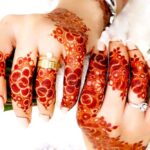
- Tikki Mehndi Design Magic 2025 Most Stunning Styles & Tips
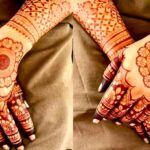
- 20+ stunning and fresh foot mehndi designs for the modern look
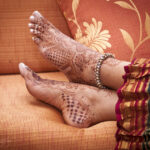
- Mehndi Dress Design and Mehendi Design in Pakistan

- Velvet Dress Design and New Mehndi Design in Pakistan

- Finger Mehndi Design Ultimate 2025 Trends and Styling Guide

- Mehndi Design Easy and Beautiful Your Gateway to Stunning Body Art
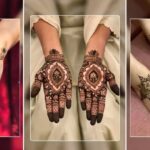
- Henna New Mehndi Design 2025 Stylish, Trendy and Easy Ideas for Every Occasion
